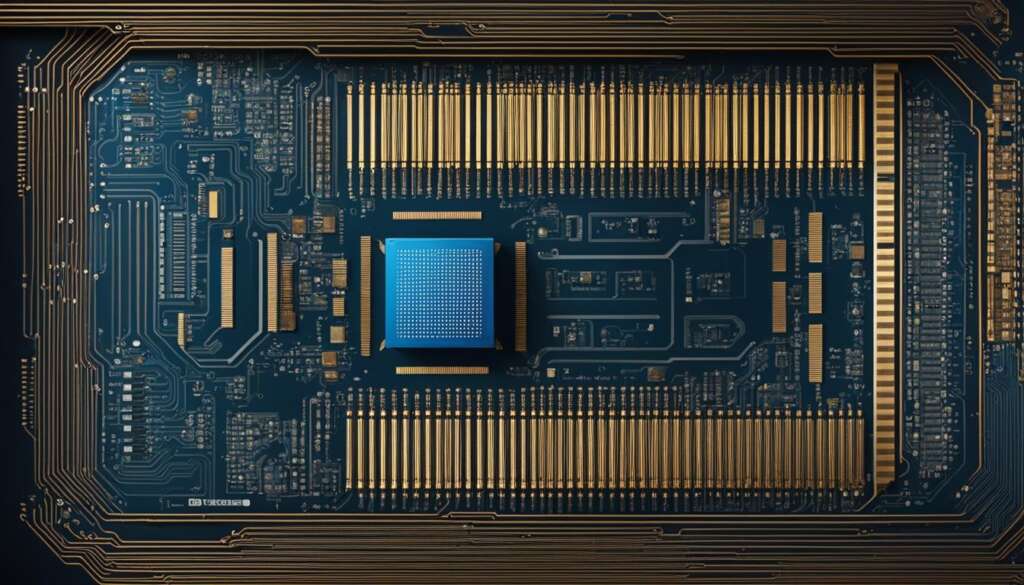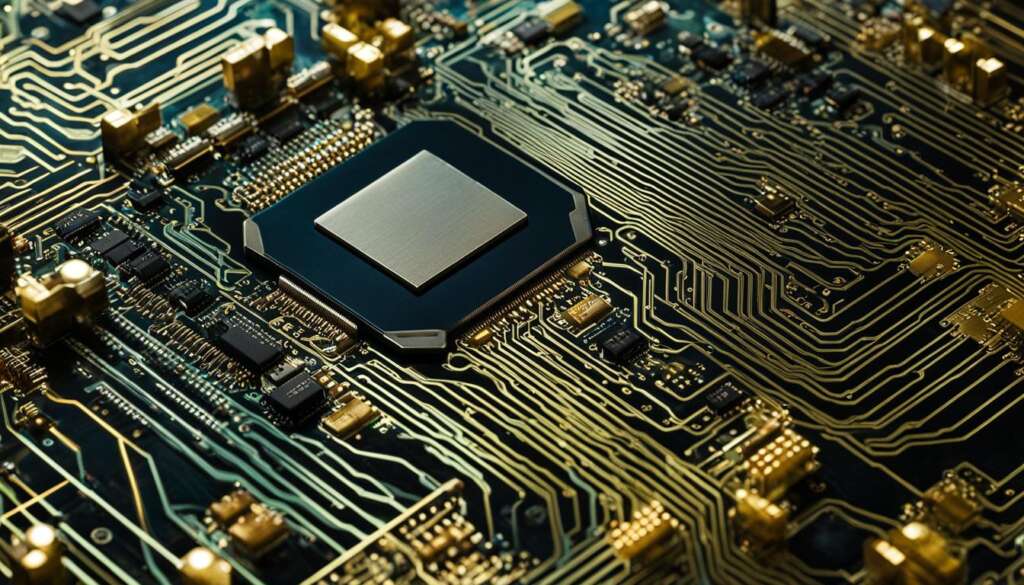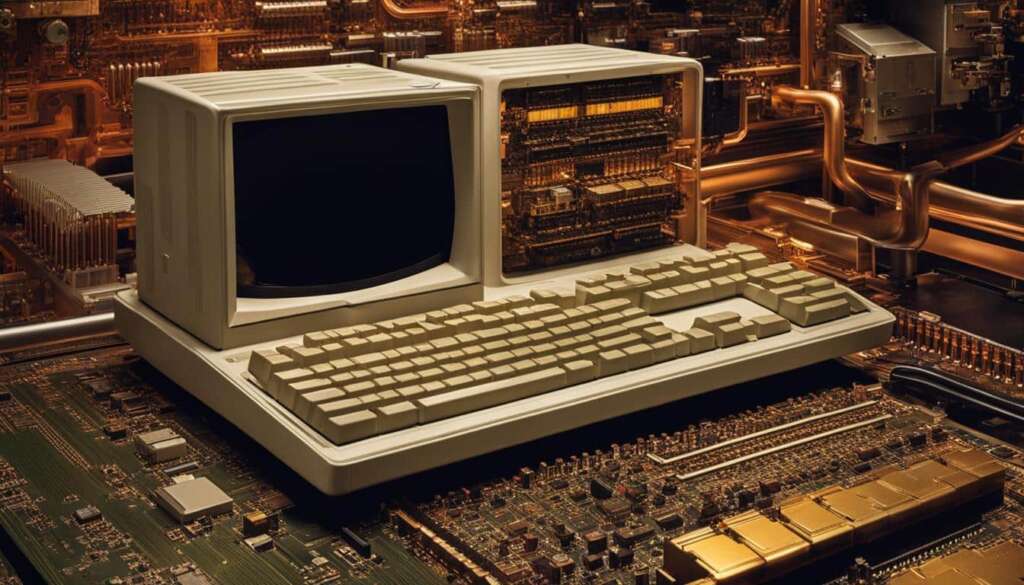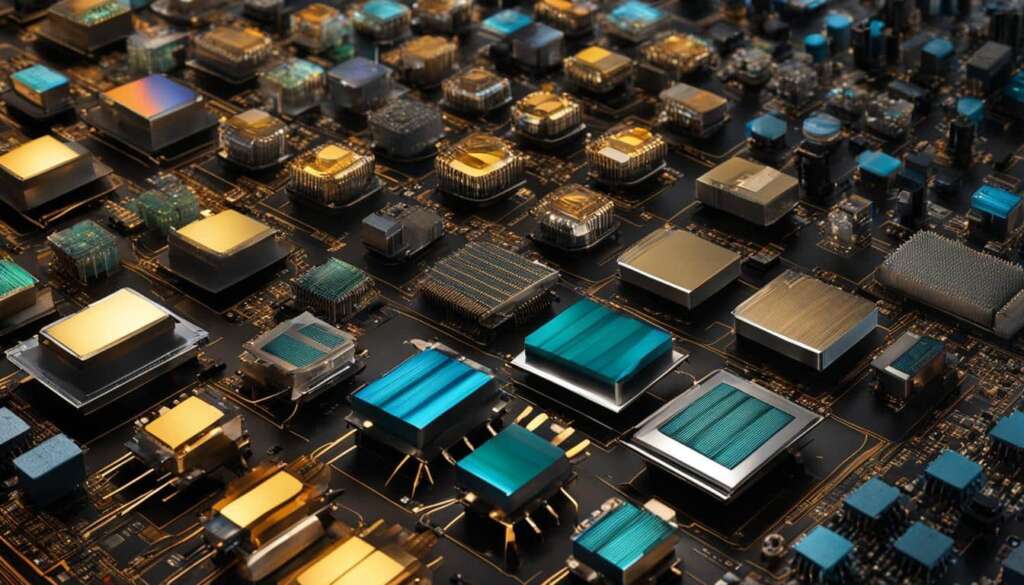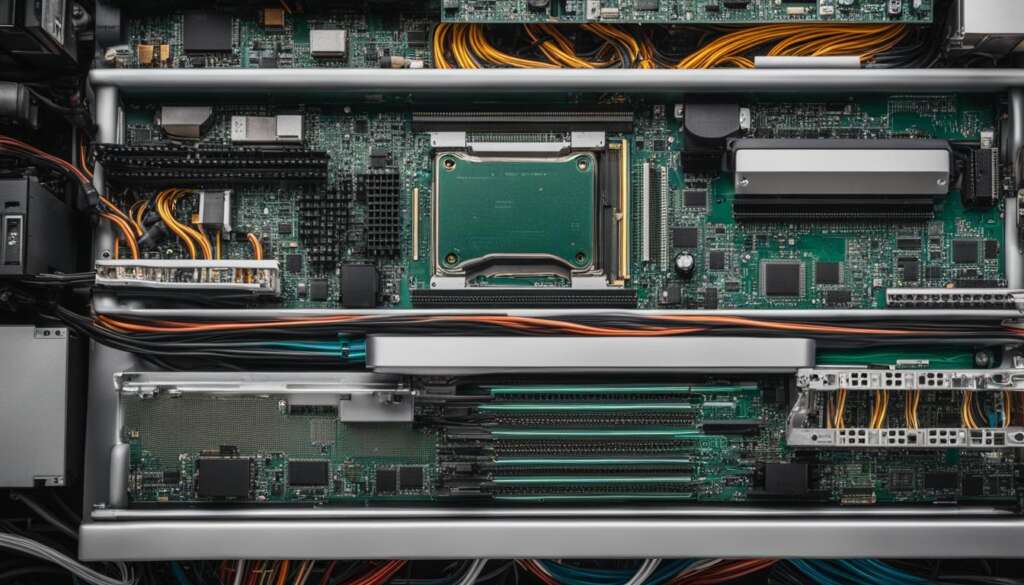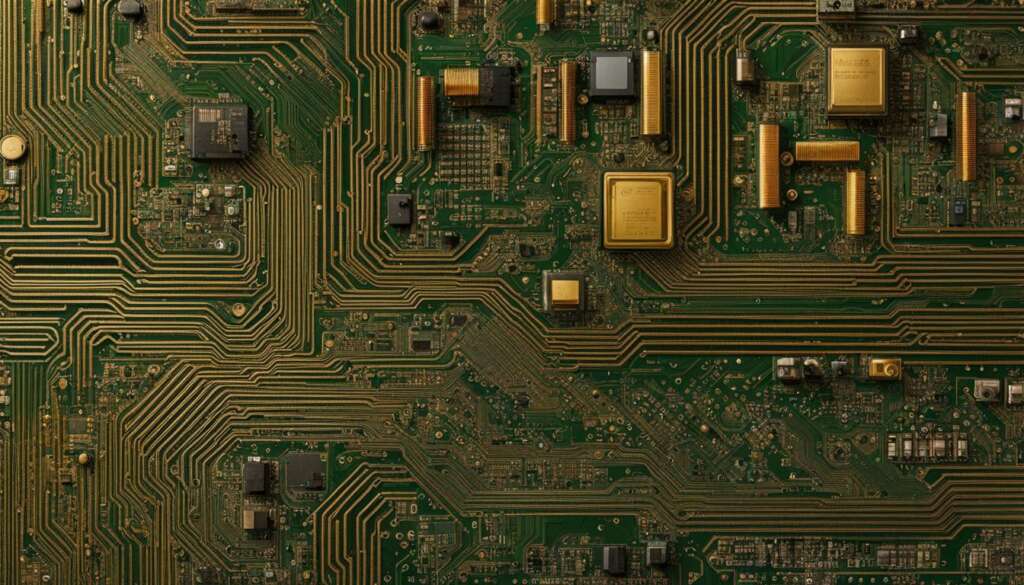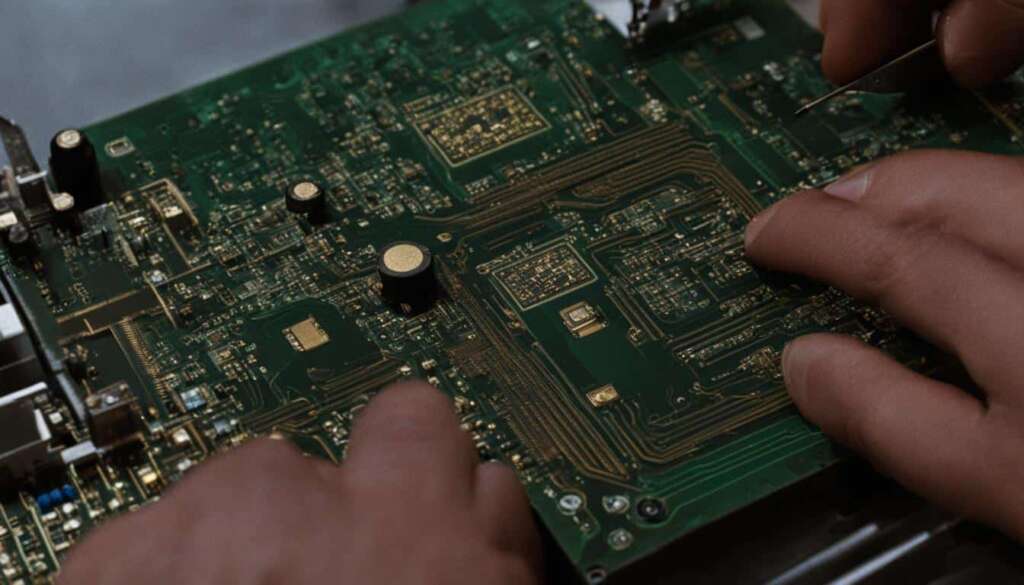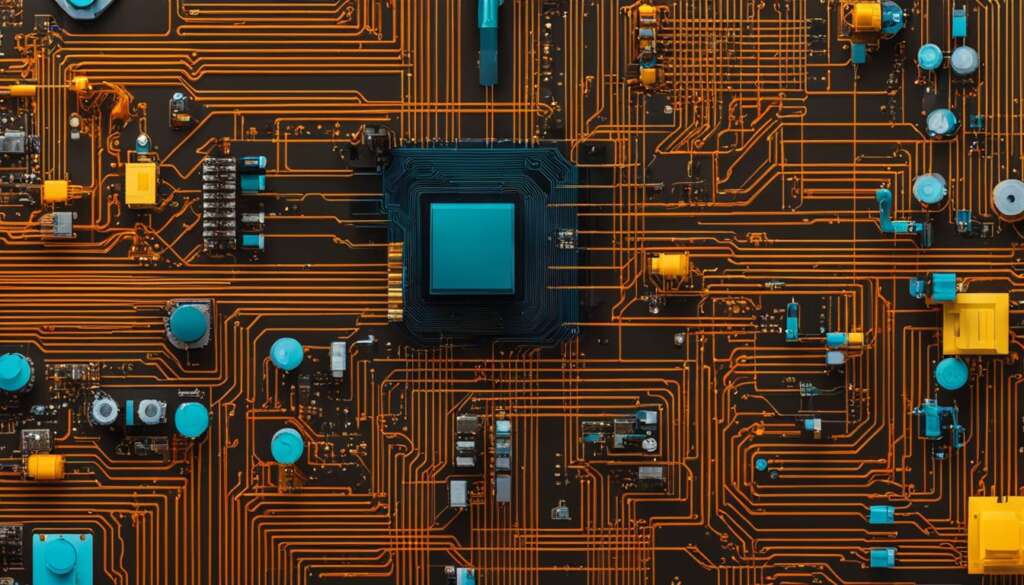Table of Contents
Welcome to our in-depth exploration of the fascinating history of processor manufacturing techniques. In this article, we will take a journey through time, tracing the evolution of processors from their humble beginnings to the powerful chips that drive today’s technology. Join us as we delve into the world of processors and uncover the secrets behind their development.
From the early days of microprocessors in the 1970s to the present, the manufacturing techniques used to create these incredible pieces of technology have undergone significant transformations. In the early years, designers relied on MOSFET transistors with pMOS logic, gradually shifting to nMOS logic. Throughout this period, there was experimentation with various word lengths, such as the emergence of 8-bit and 16-bit designs.
During this pioneering era, semiconductor masking systems like the Micralign system were introduced. These systems played a crucial role in reducing flawed chips and lowering the cost of complex designs, revolutionizing the industry.
Stay tuned as we dive deeper into the advancements in processor technology, the key players in processor manufacturing, the evolution of fabrication techniques, and the impact of Moore’s Law on this ever-evolving field. We will also explore the future prospects and compare different processor generations, along with the types and advantages/disadvantages of microprocessors.
Join us on this enlightening journey through history, and discover the incredible innovations that have shaped the world of processor manufacturing. Get ready to unlock a world of knowledge about the history of processor manufacturing techniques.
Advancements in Processor Technology
The field of processor technology has witnessed significant advancements over the years, leading to the development of increasingly powerful and efficient microprocessors. These advancements have been crucial in driving the progress of various industries and shaping the technological landscape. Let’s take a closer look at some of the key milestones in processor development.
In the 1980s, there was a significant transition from 8-bit to 16-bit processors. Designs like the Intel 8086 and Motorola 68000 offered improved performance and capabilities, paving the way for more advanced computing applications. The introduction of 32-bit processors in the same decade, such as the Intel 80386 and Motorola 68020, brought further advancements in processing power and efficiency.
“The continuous evolution of microprocessors has revolutionized the way we compute, enabling us to accomplish tasks more efficiently and effectively.”
Cache memory, multi-core processors, and virtualization capabilities have also played a vital role in enhancing the capabilities of microprocessors. These features have not only improved processing speed but also enabled the execution of multiple tasks simultaneously, increasing overall system performance. The integration of advanced features like integrated graphics processing and machine learning capabilities in modern processors, such as the Intel Core i series, has further expanded the applications and capabilities of microprocessors.
| Processor Generation | Key Advancements |
|---|---|
| 1980s | Transition to 16-bit processors |
| 1980s | Introduction of 32-bit processors |
| Modern Processors | Cache memory, multi-core processors, integrated graphics, and machine learning capabilities |
With advancements in processor technology ongoing, we can expect further innovations in the future. The development of smaller and more powerful transistors, such as 5nm and even smaller, will continue to push the boundaries of processing capabilities. Furthermore, the integration of specialized processors for emerging technologies, like quantum computing and neuromorphic computing, holds the potential to revolutionize computing even further. The future of processor technology is indeed promising and will continue to shape the way we live and work.
Key Players in Processor Manufacturing
When it comes to processor manufacturing, several key players dominate the industry. These companies have a rich history of innovation and have been at the forefront of shaping the technology landscape. Let’s take a look at some of the leading processor manufacturing companies:
Intel
Intel is undoubtedly one of the most prominent names in the world of processors. With a strong heritage in semiconductor technology, Intel has consistently delivered powerful and efficient microprocessors. Their processors power a wide range of devices, from desktop computers to data centers. Intel’s relentless commitment to research and development has allowed them to maintain their position as a leader in the industry.
AMD
Advanced Micro Devices (AMD) is another notable player in the processor manufacturing space. AMD has been a fierce competitor to Intel, particularly in the desktop and server processor market. They have gained recognition for their innovative designs and competitive pricing. AMD processors are known for offering excellent performance and value, attracting a loyal customer base.
ARM
ARM is a leading provider of energy-efficient processors used in smartphones, tablets, and other mobile devices. Their processors are designed to deliver high performance while minimizing power consumption, making them ideal for portable devices where battery life is crucial. ARM’s licensing model has allowed them to establish partnerships with various manufacturers, further expanding their reach in the market.
IBM, Qualcomm, and Samsung
In addition to Intel, AMD, and ARM, there are other significant players in the processor manufacturing industry. IBM, a technology giant, has made significant contributions to processor design and manufacturing. Qualcomm, known for its mobile processors, has played a vital role in advancing the capabilities of smartphones. Samsung, a prominent name in consumer electronics, has also made its mark in processor manufacturing, producing powerful processors for their devices.
| Company | Key Focus |
|---|---|
| Intel | Wide range of processors |
| AMD | Competition with Intel |
| ARM | Energy-efficient processors |
| IBM | Processor design and manufacturing |
| Qualcomm | Mobile processors |
| Samsung | Consumer electronics processors |
Evolution of Processor Fabrication Techniques
The evolution of processor fabrication techniques has been a crucial factor in the development of smaller, more efficient, and more powerful microprocessors. Over the years, advancements in fabrication technology have played a significant role in meeting the growing demands for improved processing capabilities.
One of the key milestones in processor fabrication was the transition from vacuum tubes to transistors in the 1950s. Transistors provided better power efficiency and enabled the production of smaller processors. This breakthrough laid the foundation for the rapid advancement of microprocessors.
Another significant development was the invention of the integrated circuit (IC) in 1958. The IC allowed for multiple transistors to be etched onto a single chip, reducing the size of processors and improving their performance. This innovation revolutionized processor manufacturing by making it possible to produce complex designs more efficiently.
Over time, fabrication techniques continued to evolve, leading to further advancements in processor technology. The decrease in line widths, increase in wafer diameters, and the addition of more layers have all contributed to the production of increasingly powerful processors at more affordable prices. These advancements have made it possible to pack more transistors onto a chip, resulting in smaller, faster, and more energy-efficient processors.
| Advancements in Processor Fabrication Techniques | Impact |
|---|---|
| Transition from vacuum tubes to transistors | Improved power efficiency and enabled smaller processors |
| Invention of the integrated circuit (IC) | Allowed for multiple transistors on a single chip, reducing size and improving performance |
| Decrease in line widths and increase in wafer diameters | Packed more transistors onto a chip, resulting in smaller, faster processors |
| Addition of more layers | Increased the complexity and power of processors |
The continuous advancement of processor fabrication techniques holds great promise for the future. As technology continues to progress, we can expect even smaller transistors and more efficient manufacturing processes. These developments will enable the production of processors with even greater power and efficiency, paving the way for future innovations in various industries.
Image source: https://seowriting.ai/32_6.png
The Impact of Moore’s Law on Processor Manufacturing
Moore’s Law, formulated by Intel co-founder Gordon Moore in 1965, has had a profound impact on the field of processor manufacturing. This principle states that the number of transistors on a microprocessor will double approximately every two years, leading to exponential growth in computing power. As a result, the processor manufacturing industry has been compelled to continuously innovate and develop more advanced processors.
Thanks to Moore’s Law, microprocessors have become smaller, more efficient, and more powerful. The ability to pack more transistors onto a chip has allowed for the creation of processors with increased performance capabilities. The relentless pursuit of miniaturization and increased transistor density has enabled the production of processors that are capable of handling complex tasks and running resource-intensive applications.
Furthermore, Moore’s Law has driven competition among leading processor manufacturers to keep up with the demands of the industry. Companies like Intel, AMD, and ARM have invested heavily in research and development to stay at the forefront of processor technology. Their efforts have resulted in the introduction of new architectures, improved energy efficiency, and enhanced processing capabilities.
Overall, the impact of Moore’s Law on processor manufacturing cannot be overstated. It has been a driving force behind the continuous evolution and advancement of microprocessors, shaping the landscape of computing and enabling technological innovations in various industries.
Future Prospects in Processor Manufacturing
The field of processor manufacturing is constantly evolving, and the future holds exciting prospects for advancements in processor technology. With the relentless pursuit of smaller and more efficient processors, the development of 5nm and even smaller transistors is expected to continue. This breakthrough will pave the way for the production of processors with unparalleled power and efficiency. The image below visualizes the potential of future processors:
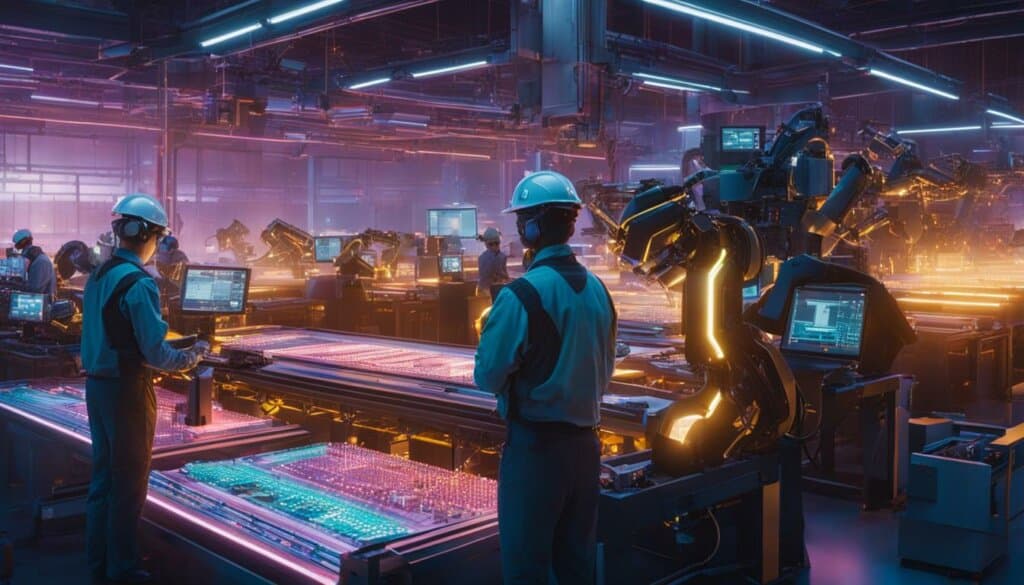
Advancements in artificial intelligence (AI) and machine learning (ML) are also driving the need for specialized processors designed to handle complex algorithms. These processors, tailored specifically for AI and ML tasks, will unlock new possibilities in areas such as deep learning, natural language processing, and computer vision.
Additionally, the integration of processors with other emerging technologies will shape the future of computing. Quantum computing, with its potential for exponential computational power, promises to revolutionize industries such as cryptography, optimization, and drug discovery. Neuromorphic computing, inspired by the human brain, aims to develop processors that can perform complex cognitive tasks efficiently.
As processor manufacturing continues to advance, it will drive innovation across various industries, from healthcare and finance to transportation and entertainment. The increasing power and efficiency of processors will enable the development of more advanced technologies and solutions, improving our lives and pushing the boundaries of what is possible in the digital age.
Key Takeaways:
- The development of smaller and more efficient transistors will lead to the production of processors with unparalleled power and efficiency.
- Specialized processors designed for AI and ML tasks will unlock new possibilities in deep learning, natural language processing, and computer vision.
- The integration of processors with emerging technologies like quantum computing and neuromorphic computing will reshape the computing landscape.
- Processor manufacturing advancements will drive innovation across various industries, improving our lives and pushing the boundaries of what is possible.
Comparison of Different Processor Generations
Over the years, microprocessors have undergone significant advancements, evolving through different generations to meet the increasing demands of computing technology. Each generation brought with it new features and capabilities, propelling the field of processor manufacturing forward. This section provides a comparison of the major processor generations, highlighting their key characteristics and contributions.
First Generation (1971-1972)
The first generation of microprocessors emerged in the early 1970s, paving the way for the digital revolution. The Intel 4004, introduced in 1971, was the world’s first commercially available microprocessor. It was a 4-bit processor that laid the foundation for subsequent generations. The initial designs utilized MOSFET transistors with pMOS logic, which evolved into nMOS logic after the mid-1970s. The first-generation processors also witnessed experiments with various word lengths, establishing the groundwork for future advancements.
Second Generation (1973-1978)
The second generation of microprocessors, spanning from 1973 to 1978, marked a significant leap forward in processing power. Key players like Intel and Motorola introduced 8-bit microprocessors, such as the Intel 8085 and Motorola 6800. These processors provided enhanced performance and expanded memory capabilities, enabling the development of more complex applications. The second-generation processors laid the foundation for the rapid growth of computing technology in the years to come.
Third Generation (1979-1980)
The introduction of 16-bit microprocessors in the late 1970s marked the third generation of processor evolution. Notably, the Intel 8086 emerged as a game-changer, revolutionizing the computing industry. This generation offered improved performance and introduced advanced features like segmented memory architecture. The advancements in 16-bit processors set the stage for the future development of more powerful and efficient microprocessors.
Fourth Generation (1981-1995)
The fourth generation of microprocessors, spanning from 1981 to 1995, brought about the era of 32-bit computing. Processors like the Intel 80386 and Motorola 68020 showcased significant improvements in processing power and memory capabilities. This generation witnessed the introduction of cache memory, multi-core processors, and virtualization capabilities, further enhancing the overall performance and efficiency of microprocessors.
Fifth Generation (1995-present)
The fifth generation of microprocessors, which began in 1995 and continues to the present day, introduced 64-bit architecture and advanced features. Processors like the Intel Core i series have become synonymous with high-performance computing, offering integrated graphics processing and machine learning capabilities. The fifth generation has witnessed the integration of processors with emerging technologies like artificial intelligence and quantum computing, paving the way for the future of computing.
| Generation | Timeline | Key Features |
|---|---|---|
| First Generation | 1971-1972 | 4-bit processors, MOSFET transistors |
| Second Generation | 1973-1978 | 8-bit processors, expanded memory capabilities |
| Third Generation | 1979-1980 | 16-bit processors, segmented memory architecture |
| Fourth Generation | 1981-1995 | 32-bit processors, cache memory, multi-core processors |
| Fifth Generation | 1995-present | 64-bit processors, advanced features like integrated graphics and machine learning |
The continuous evolution of microprocessors across different generations has shaped the landscape of computing technology, enabling the development of increasingly powerful and efficient systems. From the humble beginnings of 4-bit processors to the advanced capabilities of modern 64-bit processors, each generation has contributed to the growth and advancement of the industry.

Types of Microprocessors
Microprocessors are classified into different types based on their design and functionality. Two common types of microprocessors are Complex Instruction Set Computer (CISC) and Reduced Instruction Set Computer (RISC).
CISC Microprocessors
CISC microprocessors are designed to minimize the number of instructions per program, making them suitable for a wide range of tasks. These processors can handle complex instructions that perform multiple operations in a single instruction. They have a large instruction set, including instructions for arithmetic, logical operations, and memory access. CISC microprocessors are known for their versatility and can handle both simple and complex programs effectively.
RISC Microprocessors
RISC microprocessors, on the other hand, focus on reducing execution time by using a simplified instruction set and relying on efficient hardware. They have a smaller instruction set compared to CISC microprocessors, which allows for faster execution. RISC microprocessors use a technique called pipelining, where instructions are divided into smaller stages and executed simultaneously, resulting in improved performance.
| Type | Advantages | Disadvantages |
|---|---|---|
| CISC Microprocessors |
|
|
| RISC Microprocessors |
|
|
Other types of microprocessors include superscalar microprocessors, which have multiple execution units to process multiple instructions simultaneously, application-specific integrated circuits (ASICs) that are customized for specific applications, and digital signal multiprocessors (DSPs) that are optimized for digital signal processing tasks.
The choice between CISC and RISC microprocessors depends on the specific requirements of the application and the trade-offs between versatility and performance. Both types have their advantages and disadvantages, and designers need to consider factors like power consumption, instruction set complexity, and the nature of the tasks to be performed when selecting a microprocessor for a particular application.
Advantages and Disadvantages of Microprocessors
Microprocessors have revolutionized the world of computing, offering numerous advantages that have shaped the modern technological landscape. One of the key advantages is their high processing speed, allowing for rapid execution of complex tasks. This enables computers and devices to perform calculations, process data, and run applications with remarkable efficiency. The compact size of microprocessors is another major advantage, as it allows for the creation of smaller and more portable devices. From smartphones to smartwatches, microprocessors have made it possible to pack powerful computing capabilities into devices that can fit in the palm of your hand.
Microprocessors also offer flexibility for customization, allowing manufacturers to design processors tailored to specific requirements. This flexibility enables the creation of specialized processors optimized for tasks such as gaming, artificial intelligence, or data analysis. Additionally, microprocessors benefit from continuous improvements driven by Moore’s Law, which predicts exponential growth in computing power. This means that with each new generation of microprocessors, we see advancements in performance, efficiency, and features that further enhance their capabilities.
However, microprocessors are not without their limitations. One of the main disadvantages is the risk of overheating, especially with extended use or demanding applications. This can lead to reduced performance and potential damage to the processor. Another limitation is that the performance of microprocessors can be dependent on the size of the data they are processing. Large datasets may require more processing power and memory, which can limit the efficiency of microprocessors. Additionally, compared to microcontrollers, microprocessors typically require larger board sizes, which can be a constraint in certain applications where space is limited. Lastly, microprocessors may have limited support for floating-point operations, which can impact their performance in certain computational tasks.
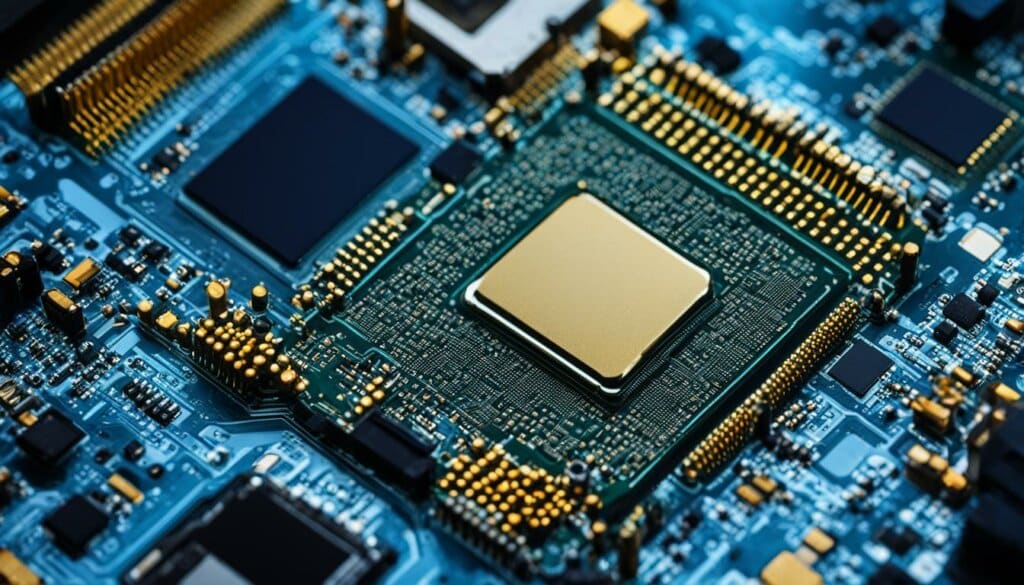
Advantages of Microprocessors:
- High processing speed
- Compact size
- Easy customization
- Continuous improvements driven by Moore’s Law
Disadvantages of Microprocessors:
- Risk of overheating
- Performance limitations with large datasets
- Larger board size compared to microcontrollers
- Limited support for floating-point operations
CONCLUSION
The history of processor manufacturing techniques has witnessed remarkable advancements with processors evolving from 4-bit designs in the 1970s to powerful 64-bit processors in the present day. Designers initially used MOSFET transistors with pMOS logic, later transitioning to nMOS logic. The introduction of masking systems like the Micralign system reduced flawed chips and lowered complex design costs.
Advancements in processor technology have focused on miniaturization and performance improvements. The transition to 16-bit processors in the 1980s brought improved performance, while cache memory, multi-core processors, and virtualization capabilities further enhanced processing power and efficiency. The latest generation of microprocessors, like the Intel Core i series, feature 64-bit architecture and advanced features.
The key players in processor manufacturing include Intel, AMD, ARM, IBM, Qualcomm, and Samsung. These companies produce microprocessors that power a wide range of devices, from desktops and servers to smartphones and tablets.
Looking ahead, the future of processor manufacturing holds exciting prospects. The development of even smaller transistors, such as 5nm and beyond, will enable the production of processors with greater power and efficiency. Advancements in artificial intelligence and machine learning are driving the need for specialized processors, and the integration of processors with emerging technologies like quantum computing will reshape the computing landscape.
FAQ
What is the history of processor manufacturing techniques?
The history of processor manufacturing techniques dates back to the 1950s when the transition from vacuum tubes to transistors improved power and efficiency. The invention of the integrated circuit (IC) in 1958 revolutionized processor manufacturing by allowing multiple transistors to be etched onto a single chip. Advancements in fabrication technology, such as decreasing line widths and increasing wafer diameters, have enabled the production of increasingly powerful processors at affordable prices.
Who are the key players in processor manufacturing?
Intel is one of the leading companies in processor manufacturing, with its microprocessors powering a wide range of devices. Other major players include AMD, which competes with Intel in the desktop and server processor market, and ARM, known for its energy-efficient processors used in smartphones and tablets. IBM, Qualcomm, and Samsung are also notable players in the processor manufacturing industry.
What are the different types of microprocessors?
Microprocessors can be classified into various types based on their design and functionality. Complex Instruction Set Computer (CISC) microprocessors are designed to minimize the number of instructions per program. Reduced Instruction Set Computer (RISC) microprocessors focus on reducing execution time by using a simplified instruction set. Other types include superscalar microprocessors, application-specific integrated circuits (ASICs), and digital signal multiprocessors (DSPs).
What are the advantages and disadvantages of microprocessors?
Microprocessors offer several advantages, including high processing speed, compact size, easy maintenance, the ability to perform complex mathematics, flexibility for customization, and continuous improvements driven by Moore’s Law. However, they also have certain disadvantages, such as the risk of overheating with extended use, performance limitations depending on data size, larger board size than microcontrollers, and limited support for floating-point operations.


